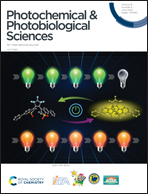In vitro photodynamic treatment of cancer cells induced by aza-BODIPYs
Abstract
Two aza-BODIPY photosensitizers (PSs, compounds 7 and 8), featuring an iodine atom on each pyrrolic unit of their structure, were synthesized in fairly good yields starting from commercial products and tested in vitro on two human cancer cell lines (HCT116 and SKOV3) to assess their photodynamic efficacy. After treating the cell cultures with variable concentrations of 7 or 8 and incubating for the desired incubation time, the cells were irradiated for two hours with a red-light emitting diode (LED) device; afterwards the extent of cell death was determined by MTT assay. Besides the killing effect, the new PSs were also studied to determine further parameters related to photodynamic efficacy, such as the resistance towards photobleaching, the rate of singlet oxygen production, the fluorescence quantum yields, the cellular uptake and the localization inside the cells and, finally, flow cytometric analysis for apoptosis. Considering the results as a whole, these aza-BODIPYs can be considered to be promising photosensitizers because of their IC50 values being below micromolar concentrations and for more rather interesting features. Actually, these molecules have proved to be: (a) quite stable towards photobleaching; (b) good producers of singlet oxygen and (c) highly penetrating the cells with a wide distribution in the cytosol. Furthermore, in accordance with the good rate of singlet oxygen production, the apoptotic cells reach 30% and this allows us to assume a low inflammatory effect of the in vivo PDT treatment; thus a possible in vivo application of these aza-BODIPYs might be plausible.



 Please wait while we load your content...
Please wait while we load your content...